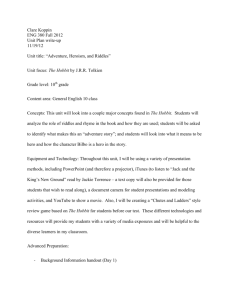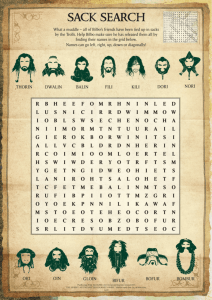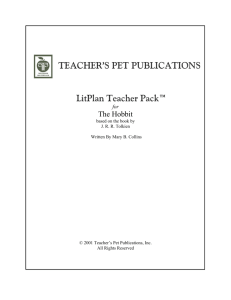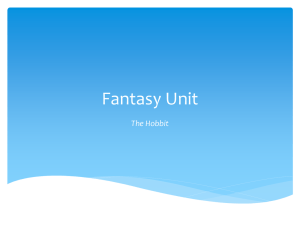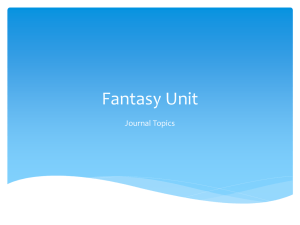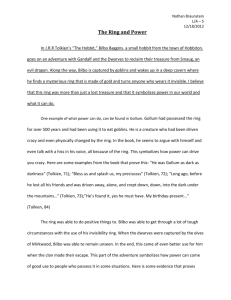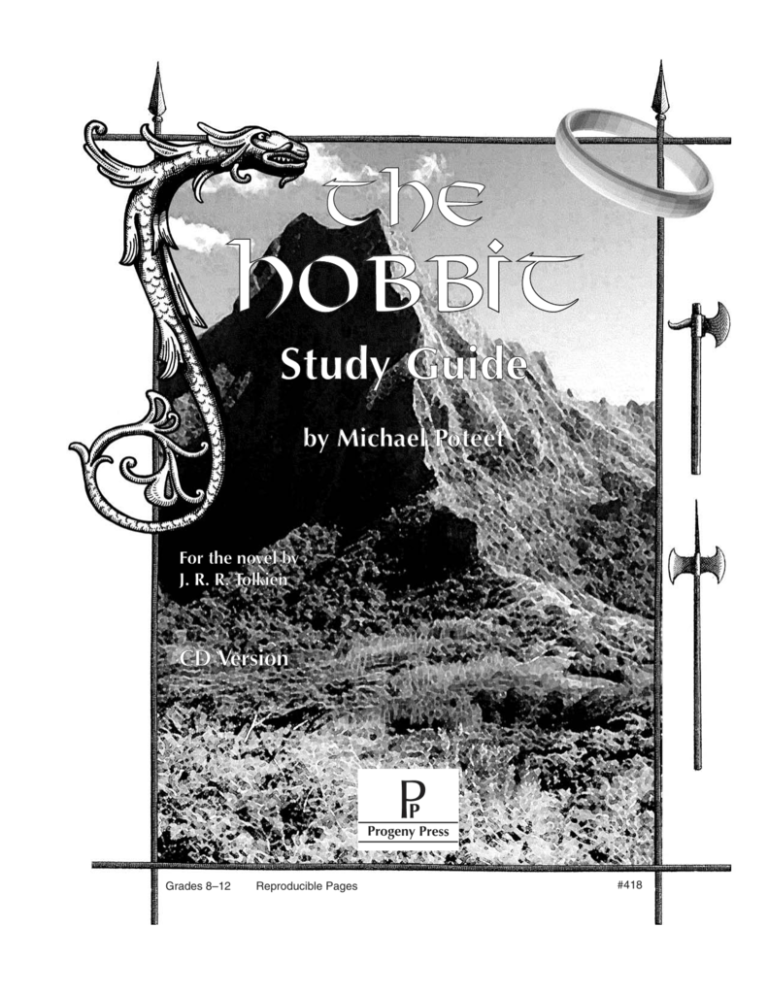
The
Hobbit
Study Guide
by Michael Poteet
For the novel by
J. R. R. Tolkien
CD Version
Grades 8–12
Reproducible Pages
#418
Limited permission to reproduce this study guide.
Purchase of this study guide entitles an individual teacher
to reproduce pages for use in the classroom or home.
Multiple teachers may not reproduce pages
from the same study guide.
Sale of any printed copy from this CD is strictly and specifically prohibited.
The Hobbit Study Guide
A Progeny Press Study Guide
by Michael Poteet
with Andrew Clausen, Michael Gilleland
Copyright © 2000 Progeny Press
All rights reserved.
Reproduction or translation of any part of this work
beyond that permitted by Section 107 or 108 of the
1976 United States Copyright Act without the written
permission of the copyright owner is unlawful.
Requests for permission or other information should be
addressed to Reprint Permissions, Progeny Press,
PO Box 100, Fall Creek, WI 54742-0100.
Printed in the United States of America.
ISBN: 978-1-58609-366-2 Book
978-1-58609-227-6 CD
978-1-58609-458-4 Set
2
© 2000 Progeny Press
No copy of this study guide may be resold.
The Hobbit Study Guide
Table of Contents
Note to Instructor .....................................................................................................4
Synopsis ....................................................................................................................5
About the Author ......................................................................................................6
Ideas for Pre-Reading Activities ...............................................................................10
Chapters 1–3 ..........................................................................................................12
Chapters 4–6 ..........................................................................................................23
Chapters 7 & 8 .......................................................................................................33
Chapters 9 & 10 .....................................................................................................40
Chapters 11–13 ......................................................................................................45
Chapters 14–19 ......................................................................................................50
Overview ................................................................................................................57
Additional Resources ..............................................................................................60
Answer Key .............................................................................................................62
© 2000 Progeny Press
No copy of this study guide may be resold.
3
The Hobbit Study Guide
Synopsis
Bilbo Baggins is a respectable hobbit—one of a race of small, quiet, country folk who
inhabit The Shire, their pastoral corner of Middle-earth—who receives an unexpected
visit from the great wizard Gandalf and thirteen dwarves. The dwarves, led by Thorin
Oakenshield, have decided to return to the land of their ancestors and reclaim the treasure taken from them years before by Smaug, a terrible dragon. On Gandalf ’s recommendation, Thorin and his company wish to enlist Bilbo as their burglar. Although
the idea of adventure appeals to something deep within him, Bilbo would much
rather stay at home where he is comfortable and safe.
Nevertheless, Bilbo is drawn into the quest and soon faces trolls, goblins, and
worse as he travels far to the Lonely Mountain, where the dwarves’ treasure awaits—as
does the dragon.
Bilbo and the dwarves share many adventures and escape many dangers before
reaching their destination. When they do, Bilbo must make a discovery on which the
success or failure of the quest depends, even as he is making important discoveries
about himself.
© 2000 Progeny Press
No copy of this study guide may be resold.
5
The Hobbit Study Guide
Chapters 4–6
Vocabulary:
For each passage in the following story, choose a word from the Word Box that is closest in meaning to the underlined word(s) or phrase.
Word Box
quaff
hordes
subterranean
uncanny
prowling
flummoxed
screech
pinnacle
brooded
scuttling
ajar
talons
abominable
benighted
onslaught
eyrie
1. The wild hawk soared away, returning to its nest (_______________) on the
highest point (_______________) of the distant mountain, clutching a dead
rat in its claws (_______________).
2. “How loathsome!” (_______________) thought Tallahassee Tom, worldfamous explorer, as he watched the hawk fly away. He meditated
(_______________) on the sight and decided the world was a brutal place
indeed.
3. With a heavy sigh, he began his descent into the underground
(_______________) cave—the same cave in which his partner, Panama Pam,
had disappeared a year earlier.
4. The deeper Tom went, the more anxious he felt, very aware that Pam was not
here and that he was alone in the darkness (_______________).
5. His boots finally touched the cave’s rock floor, and Tom would have felt
relief—were it not for the sudden, harsh scream (_______________) he heard
in the distance.
© 2000 Progeny Press
No copy of this study guide may be resold.
23
The Hobbit Study Guide
6. A lesser man would have been terrified; Tom was simply confused
(_______________).
7. What else was down here? Throngs (_______________) of rats, running
quickly (_______________) over the rocks, crying out at his intrusion? A
murderous monster, moving stealthily through (_______________) the cave’s
twists and turns, looking for prey, just like that hawk had been? Had the creature found Pam?
8. Tom shook his head, shaking off this furious attack (_______________) of
images from his overactive imagination.
9. Feeling clear-headed and clear-eyed, Tom noticed a crack in the cave’s wall.
Staring at it, he realized it was a door, carved out of the rock, and it had been
left slightly open (_______________).
10. He squeezed through the door, wondering what he would find on the other
side. To his amazed, delighted surprise, he found Pam! He asked her how she
had survived in the cave for a year. She said, “It was unnaturally strange,
(_______________) Tom—when my rope broke and I couldn’t climb out, I
found this room and this well. It’s like it was just waiting for me!”
11. As they began to drink (_______________) together the cool, clear water from
the well, Tom decided that perhaps the world was not so brutal, after all.
Riddles and Proverbs:
Riddles
The riddles in Bilbo and Gollum’s riddle contest are probably not the kind you usually tell—riddles such as “Why did the chicken cross the road?” or “How many of
something does it take to change a light bulb?” They are, for the most part, cryptic
descriptions of everyday objects—eggs, fish, and so on. The object of the contest is to
identify the thing described by the clues given. To do so, Bilbo and Gollum must use
creative thinking—for example, Bilbo must realize that “mail” in the seventh riddle
refers to the scales of a fish, not armor worn by a knight.
The narrator tells us that “the riddle-game . . . [is] of immense antiquity.” As a
professor of literature and language, Tolkien was no doubt familiar with the medieval
tradition of riddles. One eleventh-century manuscript records almost a hundred riddles.1 A scholar comments,
24
© 2000 Progeny Press
No copy of this study guide may be resold.
The Hobbit Study Guide
The interpretation of the riddles is sometimes obvious, sometimes
obscure; but the descriptive power of the poetry is often high, and the
imagery is fresh and picturesque.2
Riddles can be confusing—and fun—because they commonly use the literary techniques of epithet and metaphor.3
An epithet is “an adjective or adjectival phrase used to define a distinctive quality of a person or thing,” often “an identifying phrase that stands in place of a noun.”4
For example, “the yellow, wheel-footed beast” might be an unhappy but poetic student’s epithet for a school bus!
A metaphor is a comparison in which one thing (sometimes called “the tenor”)
is described in terms of a second, often dissimilar thing (sometimes called “the vehicle”).5 For example, the prophet Isaiah writes, “Surely the people are grass” (Isaiah
40:7c, emphasis added). The “tenor”—the Babylonian exiles—is described in terms of
the “vehicle” of grass. The metaphor suggests that the weary, disheartened captives are
as frail and feeble as withering grass.
A metaphor differs from a simile. While both metaphors and similes compare
things, a simile does so by means of the words “like” or “as”—for example, Isaiah
40:6: “All men are like grass, and all their glory is like the flowers of the field” (emphasis added).
Although Bilbo’s and Gollum’s riddles do not, medieval riddles often end with
the phrase, “Tell me what I’m called.”6
1. Identify each of the following passages as using epithet, metaphor, or simile:
a. “Fly away little birds! Fly away if you can! Come down little birds, or you
will get roasted in your nests!” ________________
b. “He is a liar, O truly tremendous one!” ________________
c. “He was watching Bilbo now from the distance with his pale eyes like telescopes.” ________________
d. “[The elves] had called it Orcrist, Goblin-cleaver, but the goblins called it
simply Biter.” ________________
© 2000 Progeny Press
No copy of this study guide may be resold.
25
The Hobbit Study Guide
2. Choose a riddle from Chapter Five that depends on metaphor. Identify the
“tenor” and the “vehicle” in that metaphor.
3. Using epithet and metaphor, write riddles describing everyday objects in your
home or school. Challenge fellow students and friends to a riddle contest!
4. The Bible contains riddles. Read Judges 14:1–19. What is the answer to
Samson’s riddle?
Proverbs:
According to The Hobbit, the familiar saying “Out of the frying-pan, into the fire” is
actually derived from the words of Bilbo Baggins! Such familiar sayings are called
proverbs.
In literary terms, a proverb is a “sentence or phrase which briefly and strikingly
expresses some recognized truth or shrewd observation about practical life . . . .”7 You
are probably already familiar with many common proverbs. “A stitch in time saves
nine,” “Blood is thicker than water,” and “It never rains but it pours” are all examples.
Proverbs in the Bible generally conform to the literary definition, but they
carry extra meaning because they are handed on for a specific purpose. Read Proverbs
1:1–7 to find out the purpose of biblical proverbs.
26
© 2000 Progeny Press
No copy of this study guide may be resold.
The Hobbit Study Guide
1. Make a list of other proverbs you know, and explain what they mean.
2. The next time you are watching television or a movie, write down any familiar
proverbs you hear characters, news anchors, or others use. Look for proverbs
when you read a newspaper or magazine. Add them to your list, and explain
what they mean.
3. Skim Proverbs 10–29. Choose at least three proverbs and explain what they
mean in your own words.
4. Choose a proverb—biblical or otherwise—and write a story explaining how
you imagine it came into being. What caused people, for example, to start saying, “A bird in the hand is worth two in the bush?”
5. Poor Richard’s Almanack by Benjamin Franklin is an important source of
proverbs in American literature. You may wish to research and read this historic
document. How many of “Poor Richard’s” sayings do you recognize and still
hear used today?
© 2000 Progeny Press
No copy of this study guide may be resold.
27
The Hobbit Study Guide
Questions:
1. What mistake do Fili and Kili make when finding a cave for shelter?
2. What is Gollum’s “birthday present”?
3. What does Bilbo leave out when he tells the dwarves about his escape from
Gollum and the goblins?
4. Why were the Wargs and goblins meeting in the forest clearing?
5. Who rescues Gandalf, Bilbo, Thorin, and the dwarves from the Wargs and
goblins?
28
© 2000 Progeny Press
No copy of this study guide may be resold.
The Hobbit Study Guide
Thinking About the Story:
6. The narrator identifies finding the ring as “a turning point in [Bilbo’s] career.”
Why?
7. At key points, the narrator talks about the ring as if it were a character with its
own personality and motivation: “The ring felt very cold as it quietly slipped
on to [Bilbo’s] groping forefinger.” “Whether it was an accident, or a last trick
of the ring before it took a new master, it was not on his finger.” This technique is called anthropomorphism (from the Greek words anthropos, “human
being,” and morphe, “form”): describing something other than a person in personal terms. What sort of “character” does the ring seem to be?
8. Gollum accuses Bilbo of being a thief. Do you think Bilbo is? Why or why not?
9. In The Lord of the Rings, we discover that Bilbo’s ring is in fact a ring of power
created for dark purposes. Even in The Hobbit, we can see the ring working its
questionable influence. How has the ring affected Gollum? What hints do you
see that it might corrupt Bilbo?
© 2000 Progeny Press
No copy of this study guide may be resold.
29
The Hobbit Study Guide
10. Even though Gandalf is a great wizard, he is afraid of the Wargs and goblins.
When can fear be healthy? Talk about a time in your life when you have felt
healthy fear.
Dig Deeper:
11. Captured by goblins, Bilbo and the dwarves descend into darkness—a common theme in myths and heroic quest stories. As Joseph Campbell explains, the
hero’s descent into darkness represents a crossing of the first “threshold to
adventure.” The hero does not ascend from darkness until either the power of
darkness has been conquered or he or she has been changed in some way—
sometimes both results occur.8 The darkness into which Bilbo and the dwarves
descend is literal, but darkness in the hero’s journey is not always or only physical. It can be spiritual, emotional, and psychological as well.
How does Bilbo defeat various powers of darkness in this portion of The
Hobbit? How does he emerge from the Misty Mountains a changed person?
Campbell sees the book of Jonah—which you read for the previous section—as
an illustration of this common theme. In what ways does Jonah fit the pattern
Campbell describes? In what ways does he not?
30
© 2000 Progeny Press
No copy of this study guide may be resold.
The Hobbit Study Guide
In the previous section, we began looking at the Christian life as a hero’s journey. Read Acts 9:1–25; 12:1–17. How do these stories about Saul and Peter
illustrate the truth that discipleship can involve a “descent into darkness”?
How does the life of Jesus show the same movement? Read Luke 4:1–15,
Romans 6:1–14, and Philippians 2:5–11. How do our lives as Christians mirror the pattern of Jesus’ life?
Some people may see the stylistic similarity of portions of the Bible with heroic
epics or mythology as evidence that it is a fallible human creation. In fact, epics
and mythology simply stylize a pattern of true experience—for example, that a
period or event of hardship (or darkness) changes and often strengthens a person. Tom Brokaw’s book about people’s experiences in World War II, The
Greatest Generation, is full of examples of true stories that fit such a pattern.
The literary pattern of a story has little to do with its authenticity or truth.
12. Note the various ways in which Tolkien uses images of light and darkness—not
only in these chapters, but also throughout The Hobbit. How do various characters and creatures react to light? What activities take place in the dark? How
might you associate these with Jesus’ words in John 3:19–21?
© 2000 Progeny Press
No copy of this study guide may be resold.
31
The Hobbit Study Guide
13. Tolkien notes that goblins “make no beautiful things, but they make many
clever ones.” Why do you think he draws this distinction?
Tolkien specifically draws attention to the reaction goblins have to weapons
made by elves. What might we infer about the nature of elf weapons from the
goblins’ reactions? Read Ephesians 6:10–18. What connections can you see
between elf weapons and “the full armor of God” we Christians are to wear?
How are we to use these “weapons”?
14. How does Bilbo’s attitude toward Gollum change as he tries to get past Gollum
at the exit to the goblin’s lair? What brings about this change? Read Luke 6:27,
28, 31, 36. Do you think Bilbo’s actions and changed attitude reflect Jesus’
instruction in these verses? Why or why not?
Notes:
1
2
3
4
5
6
7
8
C. Hugh Holman, A Handbook to Literature, 3rd ed. Based on the original by William Flint Thrall and Addison
Hibbard. (Indianapolis: Odyssey Press—Bobbs-Merill, 1972) 457.
Ibid.
Ibid.
M. H. Abrams, A Glossary of Literary Terms, 5th ed. (New York: Holt, Rinehart and Winston, Inc., 1988) 56.
Holman 313–314.
Holman 457.
Holman 421.
Campbell, Hero 77–95; see also Joseph Campbell with Bill Moyers, The Power of Myth, ed. Betty Sue Flowers (New
York: Doubleday, 1988) 146–147.
32
© 2000 Progeny Press
No copy of this study guide may be resold.
The Hobbit Study Guide
Questions:
1. The people of the Lake protect themselves by arming for war and by taking advantage of the town’s location on water
to quench Smaug’s fire—most especially by destroying the bridge from the land to the town. At the same time, the
Master tries to make a private escape.
2. Bard kills Smaug. He gets the help he needs from the thrush, which knows about the unprotected spot on Smaug’s
belly.
3. The gathering of the birds after Smaug’s death is meant as a sign of death and approaching war.
4. Roäc is the chief raven and a friend to the dwarves. He sends ravens to bring Dain to Thorin’s aid.
5. The relationship between Bilbo and Thorin changes because Thorin is angry that Bilbo took the Arkenstone and tried
to use it to get Thorin to make peace.
6. When the Goblins enter the Battle of the Five Armies, the narrator tells us that the other opponents set aside their
quarrels, for no one is a friend with the Goblins.
7. “Dragon-sickness” is greed, as the Master’s later behavior demonstrates.
Thinking About the Story:
8. There are many definitions for grim that might apply to Thorin and to Bard, including “severe,” “stern,” “unrelenting,” “forbidding,” “threatening,” and perhaps even “mirthless.” Answers and opinions will vary.
9. The Master redirects the people’s anger at the Dwarves. Answers to the other parts of the question will vary. Hitler’s
treatment of the Jewish people during the Nazi regime is one of many unfortunate and devastating examples of scapegoating in history. Often, scapegoating proves effective because it allows us to avoid facing unpleasant facts about ourselves or allows us to blame someone for things that happen for no apparent reason.
10. Answers will vary.
Dig Deeper:
11. 1 Timothy 6:10 states that the love of money is the root of all evil. The Battle of the Five Armies seems to be fought
primarily about money—everyone wants the great wealth of the treasure under the Lonely Mountain.
12. Answers will vary based on passages the students choose to study. This question lends itself well to debate format.
13. When Thorin and company arrived in Lake-town, they were hailed as heroes; but when the dragon came and things
got difficult the people of Lake-town were quite willing to blame the dwarves instead. Similarly, when Jesus entered
Jerusalem before the Passover the people praised him as a great prophet or ruler, but a few days later they turned against
him and called for his death. (Note that the people of Lake-town were “egged on” by the Master of the town and the
people of Jerusalem were persuaded by the priests.) Answers will vary, but such praise and popularity can be fickle and
fleeting. Psalm 118 says it is safe to trust in God, but not in men; and John 2 reminds us that Jesus knew not to trust in
popularity with people.
14. Thorin’s answer is curt and angry: “You put your worst cause last. . . . To the treasure of my people no man has a
claim. . . . The treasure was not [Smaug’s] that his evil deeds should be amended with a share of it. The price of the
goods and assistance that we received of the Lake-men we will fairly pay—in due time. But nothing will we give, not
even a loaf’s worth. . . .” Bard speaks some of right and dues, but he also speaks of charity and goodwill. Thorin speaks
only of right of ownership. He seems unable to see anyone’s position but his own and to be very defensive. The verses
cited speak of our duty to be generous, to have pity, to love others with our actions and provide for their needs. Thorin
has become possessive, selfish, and blind to the pain of others. This is not how God wishes us to behave.
15. Thorin’s end almost perfectly illustrates these verses, though he repents his deeds in the end. He struggled valiantly
to gain the treasure hoard, struggled mightily to keep it, but in the end he died and was never able to enjoy it or keep it.
In the end the only thing that matters is the good we do and our relationship with God—everything else can be gone in
an instant. Answers will vary about how things could have been different.
16. Answers will vary. The ethics in a situation such as this can be very convoluted. Bilbo himself feels he is doing the
right thing, but feels guilty and miserable doing it. The issue may boil down to whether Bilbo was stealing the
Arkenstone, whether he had the right to give it away, and whether it was a betrayal of trust. The students should keep in
mind, however, that whatever their answer, the ends never automatically justify the means; and just because a person
acts with sincere heart does not automatically make his actions right. Accept reasonable and well-reasoned answers.
© 2000 Progeny Press
No copy of this study guide may be resold.
69



